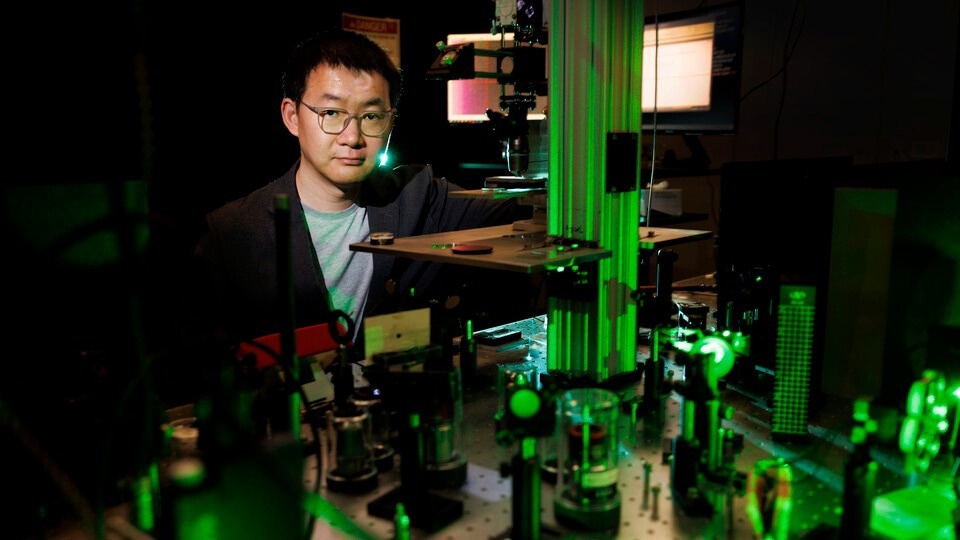Reviewed by Lexie CornerMay 15 2024
A scientist at the University of Nebraska is searching for solutions that could result in the creation of novel materials and applications.
 Yinsheng Guo, Assistant Professor of Chemistry, has received a National Science Foundation CAREER award for his research into metal halide perovskites. Image Credit: Craig Chandler/University Communication and Marketing.
Yinsheng Guo, Assistant Professor of Chemistry, has received a National Science Foundation CAREER award for his research into metal halide perovskites. Image Credit: Craig Chandler/University Communication and Marketing.
In recent years, metal halide perovskites have become an extremely effective, affordable semiconducting material for solid-state lighting, solar energy, and other applications. Despite their increasing use, a basic knowledge of the origins of their exceptional qualities is lacking.
Yinsheng Guo, an assistant professor of chemistry at the University of Nebraska–Lincoln, is also interested in changing how graduate and undergraduate students are taught physical chemistry. These students frequently find it difficult to comprehend and apply what they have learned in the classroom to the laboratory and STEM fields.
Guo’s research and teaching initiative is supported by a five-year, $648,335 grant from the National Science Foundation’s Faculty Early Career Development Program.
The importance of photovoltaic technology in the energy portfolio will continue to grow globally, and in the US, such growth is fueled by the continuous investment and innovation in new technologies.
Yinsheng Guo, Assistant Professor, Department of Chemistry, University of Nebraska–Lincoln
Metal halide perovskites (MHPs), which “have become a star material in the last decade,” are a key component of these technologies. Perovskites are a class of materials with different crystal structures consisting of interconnected octahedral units composed of metal and oxide or halide ions.
The widely defined perovskite family is notable for its superconducting and ferroelectric characteristics, which have sparked interest in both fundamental science and materials engineering. As scientists have learned more about MHPs’ capacity to absorb and release photons of light, as well as harvest electricity, perovskites have emerged as a far less expensive, easier-to-scale alternative to silicon for application in energy systems.
According to Guo, MHPs can be employed as semiconducting materials in a wide range of applications, including solar energy, solid-state lighting, lasers, photodetectors, and general optoelectronic applications.
However, Guo added, “A comprehensive and consistent understanding of the origin of the many outstanding optoelectronic properties is still lacking despite being intensively pursued.”
His study aims to address fundamental problems concerning MHPs.
According to Guo, MHPs’ remarkable performance is unexpected considering their defect-prone, low-temperature, solution-processed nature.
He and his team aim to measure and regulate MHPs' unique structural dynamics to better understand their extraordinary electrical capabilities and enable their future development and commercialization.
A greater understanding of the design concepts behind MHPs could aid in creating other new materials.
Guo also wants to alter the way that students think about physical chemistry.
“Chemistry is the central science and serves as the physical foundation for advancements in both biomedical and material fields; a good conceptual understanding of the physical and chemical principles enables and empowers a future science, technology, engineering, and mathematics workforce,” Guo added.
Guo stated that in his experience as a teacher, students of all levels have difficulty grasping that conceptual knowledge, which might be made worse by the disparities in the early physical science education that children receive.
He noted, “Students’ learning is often compartmentalized. Undergraduate students often assume an exam-oriented mentality and do not find the course content and skills transferrable in their career and life. Graduate students often are challenged to transfer course content into research skills.”
Guo's CAREER project aims to provide a computational and experiential method to tackle the difficulties of teaching and learning physical chemistry. Guo stated that he will use easily accessible computational resources to reduce learning barriers and help students acquire greater conceptual knowledge through hands-on, active learning.
Computational literacy is also a key factor for the next generation of STEM employees, especially in an age where machine intelligence is essential. After developing computational abilities, students will be directed to examine scientific data further, such as mapping spectra—a visual representation of light intensity—to musical notes. The objective is to create molecularly encoded music as a bridge between science and art.
The CAREER award from the National Science Foundation funds pre-tenured faculty members who demonstrate exceptional research, top-notch teaching, and the integration of research and education, consequently embodying the role of teacher-scholars.